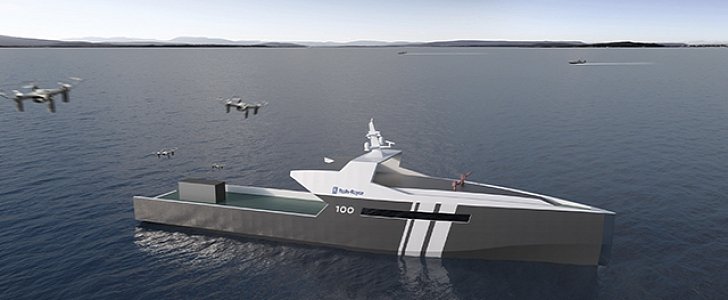Nobody is certain about the exact date self-driving cars will become a common occurrence on our streets, but everyone seems to agree that the day is coming. With busy traffic, a very clearly defined infrastructure to follow, thousands of street signs to interpret and even more pedestrians to anticipate, the AI-controlled vehicles are dealing with a very complex situation.
For an aircraft, a lot of these headaches would become obsolete, so it would make sense to have autonomous planes or drones ahead of ground vehicles. After all, that's where the term "auto pilot" was first introduced, right?
But how about the open sea? With the vast stretches of water and slow speeds, they too would make an ideal setting for automated vessels. Rolls-Royce certainly appears to think that, and the company is not alone.
It has recently revealed plans for an uncrewed autonomous patrol ship that could operate for extended periods of time (up to 100 days). Another advantage of not having humans on board would be the reduction in size (no crew quarters, mess, supply storage), but also the fact that it wouldn't risk any lives in case of a riskier mission.
Even though the proposed design doesn't include any weapons - it is, after all, a patrol ship - the prototype does have a few aces up its sleeve. For instance, the electric propulsion with 3,000 kWh of energy storage capabilities means it can run silently and keep tabs on enemy submarines. The ship also gets solar panels to extend its battery range even further.
When the inevitable happens and it gets depleted, the ship uses two generators with a combined output of 4 MW to recharge the battery and power the 1.5 MW electric motor. Of course, that means exiting silent mode, so it better be out of torpedo range by then.
The drone ship is said to have a maximum speed of over 25 knots (29 mph or 47 km/h, for those not familiar with the naval units), which isn't fast but should be enough for the type of missions it is designed to undertake. Speaking of those, it has a modular system allowing it to fulfill several roles depending on the selected setup.
“Over the next 10 years or so, Rolls-Royce expects to see the introduction of medium sized unmanned platforms, particularly in leading navies, as the concept of mixed manned and unmanned fleets develops. With our experience and capabilities, we expect to lead the field."
For now, the company did not name any clients nor did it present a production schedule for a marketable product. However, autonomous technology is definitely coming to the sea, and Rolls-Royce might be one of the bigger names in the business.
But how about the open sea? With the vast stretches of water and slow speeds, they too would make an ideal setting for automated vessels. Rolls-Royce certainly appears to think that, and the company is not alone.
It has recently revealed plans for an uncrewed autonomous patrol ship that could operate for extended periods of time (up to 100 days). Another advantage of not having humans on board would be the reduction in size (no crew quarters, mess, supply storage), but also the fact that it wouldn't risk any lives in case of a riskier mission.
Even though the proposed design doesn't include any weapons - it is, after all, a patrol ship - the prototype does have a few aces up its sleeve. For instance, the electric propulsion with 3,000 kWh of energy storage capabilities means it can run silently and keep tabs on enemy submarines. The ship also gets solar panels to extend its battery range even further.
When the inevitable happens and it gets depleted, the ship uses two generators with a combined output of 4 MW to recharge the battery and power the 1.5 MW electric motor. Of course, that means exiting silent mode, so it better be out of torpedo range by then.
The drone ship is said to have a maximum speed of over 25 knots (29 mph or 47 km/h, for those not familiar with the naval units), which isn't fast but should be enough for the type of missions it is designed to undertake. Speaking of those, it has a modular system allowing it to fulfill several roles depending on the selected setup.
“Over the next 10 years or so, Rolls-Royce expects to see the introduction of medium sized unmanned platforms, particularly in leading navies, as the concept of mixed manned and unmanned fleets develops. With our experience and capabilities, we expect to lead the field."
For now, the company did not name any clients nor did it present a production schedule for a marketable product. However, autonomous technology is definitely coming to the sea, and Rolls-Royce might be one of the bigger names in the business.



